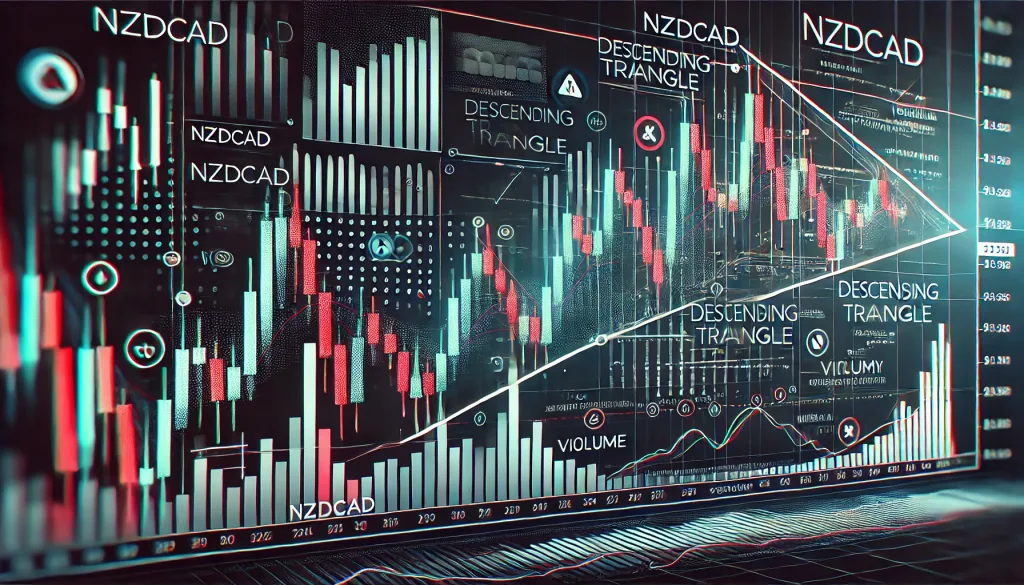NZDCAD and the Descending Triangle: The Secret Pattern Most Traders Overlook

The Market’s Best-Kept Secret: NZDCAD’s Descending Triangle
If you’ve ever felt like the Forex market was designed specifically to test your patience, you’re not alone. Trading NZDCAD inside a descending triangle can feel like waiting for your coffee to cool—excruciatingly slow, but if you time it right, the reward is chef’s kiss perfection.
Most traders either don’t spot this pattern or misunderstand its potential. But that’s where the hidden opportunities lie. In this guide, we’ll break down why the descending triangle on NZDCAD is a game-changer, how to trade it like an absolute pro, and how to avoid the mistakes that trap 90% of traders.
The Descending Triangle: Not Just a Fancy Name
A descending triangle is a bearish continuation pattern that occurs when price forms a series of lower highs while testing a strong support level multiple times. It’s basically the financial equivalent of a toddler banging on a locked door—it’s only a matter of time before it breaks through.
Spotting the Descending Triangle in NZDCAD
- Flat Support Level: The price repeatedly tests a horizontal support level but doesn’t break through—yet.
- Lower Highs: Sellers are stepping in at progressively lower levels, indicating weakening buyer momentum.
- Breakout Potential: Eventually, the pressure builds up enough, and the price either crashes through support or fakes out traders before reversing.
Why does this pattern work so well on NZDCAD? Because this pair is heavily influenced by commodity prices and risk sentiment, making it prone to these slow-squeeze setups before a major move.
Why Most Traders Get NZDCAD’s Descending Triangle Wrong
Mistake #1: Jumping in Too Early
Most traders see the triangle forming and immediately start placing sell orders. But just because a setup is forming doesn’t mean it’s time to enter. A confirmed breakout (or rejection) is what separates professionals from emotional traders.
Mistake #2: Ignoring Volume and Confirmation
A true breakout needs strong volume confirmation. If the price slips below support but lacks volume, you might be walking into a trap—like buying a used car that looks great until you realize the engine is missing.
Mistake #3: Misplacing Stop-Loss Orders
If you set your stop-loss too tight, you’ll likely get wicked out before the real move happens. If it’s too wide, your risk-reward ratio becomes garbage. The sweet spot? Just outside the last lower high or above a fakeout zone.
Elite Strategies for Trading NZDCAD’s Descending Triangle
1. The Breakout and Retest Method
- Wait for a confirmed breakdown below the support level.
- Enter on the retest of the broken support (now acting as resistance).
- Set stop-loss slightly above the retest zone.
- Target a move equal to the height of the triangle.
2. The Fakeout Trap
- If the price temporarily breaks below support but quickly reclaims it, go long.
- Set a tight stop below the fakeout wick.
- Ride the squeeze higher as trapped sellers fuel a short-covering rally.
3. Using Smart Trading Tools
- Automated lot size calculators (like StarseedFX’s Smart Trading Tool) help optimize risk.
- Trading journals track and refine your setups.
- Economic indicators help confirm if fundamental forces align with technicals.
Expert Insights on NZDCAD and Descending Triangles
According to John Murphy, legendary technical analyst:
“Triangle formations are one of the most reliable continuation patterns. The key is patience—waiting for a confirmed break.”
A recent Bank for International Settlements (BIS) study found that retail traders often misinterpret descending triangles, with 74% of retail traders getting trapped in false breakouts.
Real-World Example: In September 2023, NZDCAD formed a textbook descending triangle around the 0.8300 support level. Many traders anticipated a breakdown but were shaken out by a fakeout rally before the true bearish move. Those who waited for confirmation before entering saw a 220-pip move unfold in their favor.
Conclusion: The Ultimate Playbook for NZDCAD’s Descending Triangle
If you’re trading NZDCAD and see a descending triangle forming, remember:
✔ Patience is key—wait for the confirmation, not just the setup.
✔ Volume tells the real story—if the breakout lacks volume, it’s likely a trap.
✔ Risk management makes or breaks your trade—adjust stop-losses smartly.
✔ Use tools that give you an edge, like trading journals, risk calculators, and economic indicators.
Want to level up? Get free access to StarseedFX’s elite trading tools:
???? Smart Trading Tool
???? Free Trading Journal
???? Forex News Today
—————–
Image Credits: Cover image at the top is AI-generated
PLEASE NOTE: This is not trading advice. It is educational content. Markets are influenced by numerous factors, and their reactions can vary each time.

Anne Durrell & Mo
About the Author
Anne Durrell (aka Anne Abouzeid), a former teacher, has a unique talent for transforming complex Forex concepts into something easy, accessible, and even fun. With a blend of humor and in-depth market insight, Anne makes learning about Forex both enlightening and entertaining. She began her trading journey alongside her husband, Mohamed Abouzeid, and they have now been trading full-time for over 12 years.
Anne loves writing and sharing her expertise. For those new to trading, she provides a variety of free forex courses on StarseedFX. If you enjoy the content and want to support her work, consider joining The StarseedFX Community, where you will get daily market insights and trading alerts.
Share This Articles
Recent Articles
The GBP/NZD Magic Trick: How Genetic Algorithms Can Transform Your Forex Strategy
The British Pound-New Zealand Dollar: Genetic Algorithms and the Hidden Forces Shaping Currency Pairs
Chande Momentum Oscillator Hack for AUD/JPY
The Forgotten Momentum Trick That’s Quietly Dominating AUD/JPY Why Most Traders Miss the Signal
Bearish Market Hack HFT Firms Hope You’ll Never Learn
The One Bearish Market Hack High Frequency Traders Don't Want You to Know The

